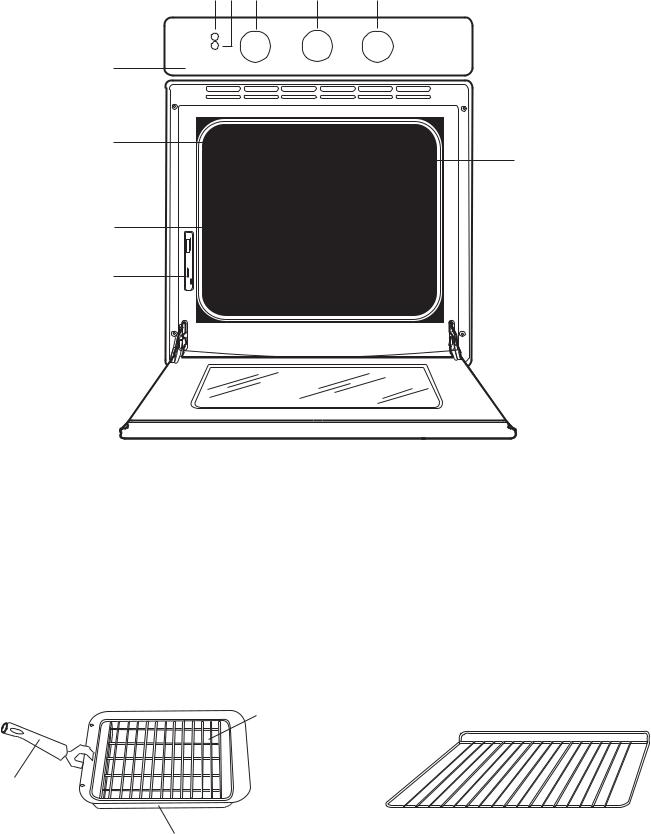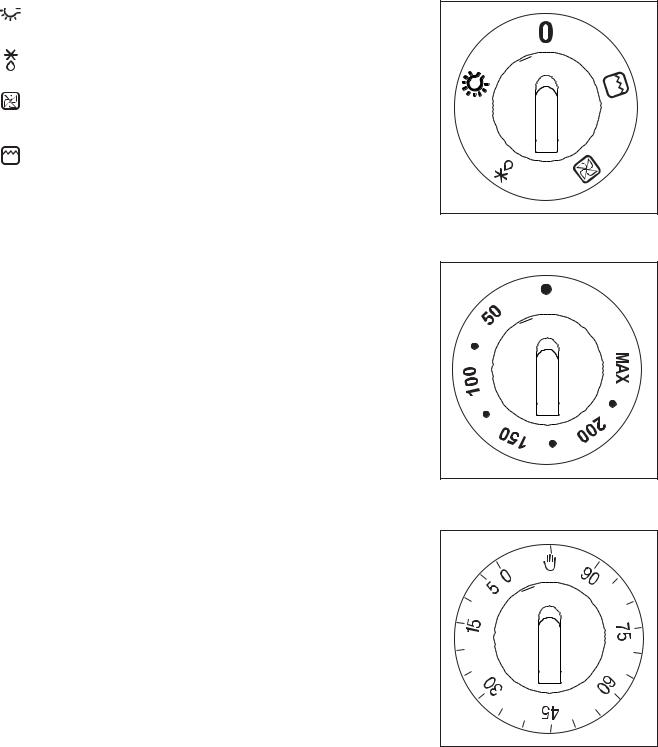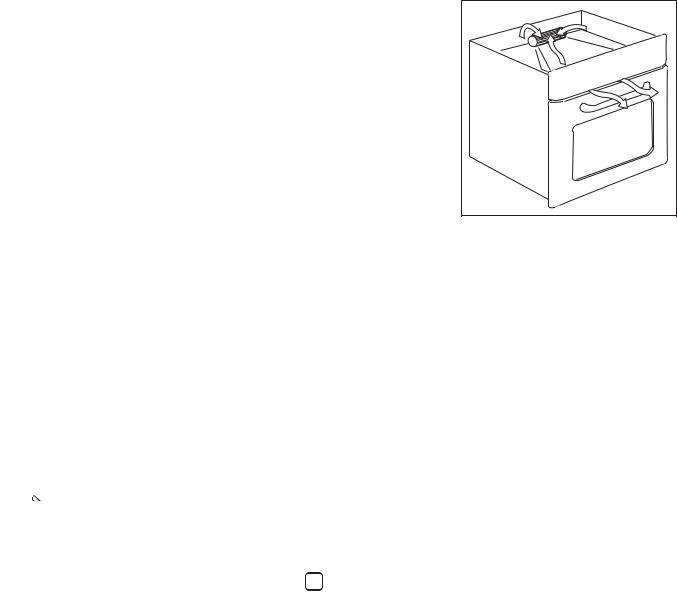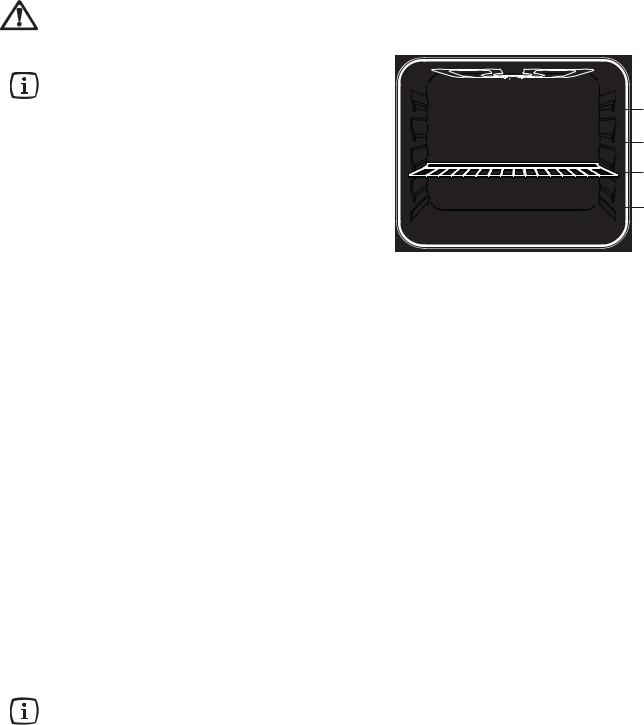Zanussi ZBF260X User Manual

BUILT-IN OVEN
ZBF 260
INSTRUCTION BOOKLET
Please read this instruction booklet before using the appliance
GB

 Important Safety Information
Important Safety Information
You MUST read hese warnings carefully before installing or using the hob. If you need assistance, contact our Customer Care Department on 08705 727727
Installation
•This oven must be installed by qualified personnel to the relevant British Standards.
•This oven is heavy. Take care when moving it.
•Remove all packaging, both inside and outside the oven, before using the oven.
•Do not attempt to modify the oven in any way.
Child Safety
•This oven is designed to be operated by adults. Do not allow children to play near or with the oven.
•The oven gets hot when it is in use. Children should be kept away until it has cooled.
•When using other electrical appliances, ensure the cable does not come into contact with the hot surfaces of the oven.
Maintenance and Cleaning
•Onlycleanthisoveninaccordancewiththeinstructions.
•The oven should be kept clean at all times. A build-up of fats or other foodstuffs could result in a fire, especially in the grill pan.
•Never use steam or high pressure steam cleaners to clean the appliance.
•Always allow the oven to cool down and switch off the electrical supply before carrying out any cleaning or maintenance work.
During Use
•This oven is intended for domestic cooking only. It is not designed for commercial or industrial purposes.
•Appliances become very hot with use, and retain their heat for long periods after use. Care should be taken to avoid touching heating elements inside the oven.
•Always stand back from the oven when opening the oven door during cooking or at the end of it to allow any build up of steam or heat to release.
•Never line any part of the oven with aluminium foil.
•Do not allow heatproof cooking material, e.g. roasting bags, to come into contact with oven elements.
•Never place plastic or any other material which may melt in or on the oven.
•Do not place sealed cans or aerosols inside the oven. They may explode if they are heated.
•Do not hang towels, dishcloths or clothes from the oven or its handle.
•Do not use this oven if it is in contact with water and never operate it with wet hands.
•Take great care when heating fats and oils as they will ignite if they become too hot.
•Alwaysuseovenglovestoremoveandreplacefoodin theoven.
•Ensure that all control knobs are in the OFF position when not in use.
•Do not leave cookware containing foodstuffs, e.g. fat or oil in or on the oven in case it is inadvertently switched ON.
Service
•This oven should only be repaired or serviced by an authorisedServiceEngineerandonlygenuineapproved spare parts should be used.
 Environmental Information
Environmental Information
•After installation, please dispose of the packaging with due regard to safety and the environment.
•Whendisposingofanoldappliance,makeitunusable, by cutting off the cable. Remove any door catches, to prevent small children being trapped inside.
•The symbol  on the product or on its packaging indicates that this product may not be treated as household waste. Instead it shall be handed over to the applicable collection point for the recycling of electrical and electronic equipment. By ensuring this product is disposed of correctly, you will help prevent potential negative consequences for the environment and human health, which could otherwise be caused by inappropriate waste handling of this product. For more detailed information about recycling of this product, please contact your local city office, your household waste disposal service or the shop where you purchased the product.
on the product or on its packaging indicates that this product may not be treated as household waste. Instead it shall be handed over to the applicable collection point for the recycling of electrical and electronic equipment. By ensuring this product is disposed of correctly, you will help prevent potential negative consequences for the environment and human health, which could otherwise be caused by inappropriate waste handling of this product. For more detailed information about recycling of this product, please contact your local city office, your household waste disposal service or the shop where you purchased the product.
Keep this instruction book for future reference and ensure it is passed on to any new owner.
2

Contents
For the User |
|
For the Installer |
|
Important Safety Information |
2 |
Installation |
17 |
Description of the Oven |
4 |
Electrical Connection |
17 |
Controls |
5 |
Building In |
18 |
Before the First Use |
6 |
|
|
Using the Oven |
7 |
|
|
Hints and Tips |
7 |
|
|
The Fan Oven |
8 |
|
|
Cooking chart - Fan Oven |
9 |
|
|
Grilling |
10 |
|
|
Defrosting |
11 |
|
|
Cleaning the Oven |
12 |
|
|
Replacing the Oven Light |
13 |
|
|
Something not working |
14 |
|
|
Service and Spare Parts |
15 |
|
|
Customer Care |
15 |
|
|
Guarantee Conditions |
16 |
|
|
Guide to use the instructions
The following symbols will be found in the text to guide you throughout the Instructions:
 Safety Instructions
Safety Instructions
)Step by step instructions for an operation  Hints and Tips
Hints and Tips
Environmental information
This appliance complies with the following E.E.C.
Directives:
*73/23 - 90/683(Low VoltageDirective); *93/68(General Directives);
*89/336(ElectromagneticalCompatibilityDirective) and subsequent modifications.
3

Description of the Oven
6 5 |
4 |
3 |
2 |
1
7
8
9
10
1. |
Control panel |
6. |
Mains on Light |
2. |
Oven Control Function Knob |
7. |
Grill |
3. |
End of cooking Programmer |
8. |
Oven Light |
4. |
Thermostat Control Knob |
9. |
Oven Fan |
5. |
Thermostat Control Light |
10.Rating Plate |
|
Oven accessories
Grill Pan
Grid
Removable handle
Anti-tip shelf (x 2)
Grill / Roasting pan
4

Controls
Oven Function Control Knob (Fig. 1)
Oven Light - The oven light will be on without any cooking function.
Defrost Setting - This setting is intended to assist in thawing of frozen food.
Fan cooking - This allows you to roast or roast
and bake simoultaneously using any shelf, without flavour transference.
Grill - The heat comes from the top element only.
Thermostat Control Knob (°C)
Turn the thermostat control knob clockwise to select temperatures between 50°C and MAX (230°C) (Fig. 2).
Thermostat Control Light
The thermostat control light will come on when the thermostat control knob is turned. The light will remain on until the correct temperature is reached. It will then cycle on and off to show the temperature is being maintained.
Mains on Light
The mains on light will come on when the oven function control knob is set.
End of cooking programmer
This device (Fig. 3) allows you to make the oven switch off automatically once the preset time is over.An acousitic signal will be heard when the cooking is completed.The cooking duration can be set up to 90 minutes maximum. Place food in the oven and turn the oven function control knob and the thermostat control knob on the required settings. Turn the timer knob to maximum time position, then turn it back to set the required cooking time. When the cooking time is over, an acoustic alarm will sound and the oven will switch off automatically.
Turn the timer knob on  to set the oven on manual operation.
to set the oven on manual operation.
Fig. 1
Fig. 2
Fig. 3
5

The Safety Thermostat
This oven is provided with a safety thermostat. In case of malfunctioning of the main thermostat, and consequent over-heating, the safety device will stop the power supply to the appliance. If this happens, call your local Service Force Centre. Under no circumstances should you attempt to repair the appliance yourself.
The cooling fan
The cooling fan operates during cooking. Air is expelled through vents between the oven door and the control panel, as shown in the diagram.
The cooling fan may run on after the oven is switched off to keep the controls cool. This is quite normal.
Before the First Use
Remove all packaging, both inside and outside the oven, before using the oven.
Before first use, the oven should be heated without food. During this time, an unpleasant odour may be emitted. This is quite normal.
1.Switch the oven function control knob to fan cooking  .
.
2.Set the thermostat control knob to MAX.
3.Open a window for ventilation.
4.Allow the oven to run empty for approximately 45 minutes.
This procedure should be repeated with the grill  function for approximately 5-10 minutes.
function for approximately 5-10 minutes.
FO 2259 |
Fig. 4
6

Using the Oven
Always cook with the oven door closed.
Stand clear when opening the drop down oven door. Do not allow it to fall open - support the door using the door handle, until it is fully open.
The oven has four shelf levels, and is supplied with two shelves. The shelf positions are counted from the bottom of the oven as shown in the diagram.
It is important that these shelves are correctly positioned as shown in the diagram.
Do not place cookware directly on the oven base.
Attention! - Do not place objects on the oven base and do not cover any part of the oven with aluminium foil while cooking, as this could cause a heat build-up which would affect the baking results and damage the oven enamel. Always place pans, heat-resisting pans and aluminium trays on the shelf which has been inserted in the shelf runners.
4
3
2
1
 Hints and Tips
Hints and Tips
Condensation and steam
The oven is supplied with an exclusive system which produces a natural circulation of air and the constant recycling of steam. This system makes it possible to cook in a steamy environment and keep the dishes soft inside and crusty outside. Moreover, the cooking time and energy consumption are reduced to a minimum. During cooking steam may be produced which can be released when opening the oven door. This is absolutely normal.
However, always stand back from the oven when opening the oven door during cooking or at the end of it to allow any build up of steam or heat to release.
When food is heated, it produces steam in the same way as a boiling kettle does. When steam comes in contact of the oven door glass, it will condense and produce waterdroplets. To reduce condensation, ensure the oven is well heated before placing food in the oven cavity. A short oven preheating (about 10 minutes) will then be necessary before any cooking. We recommend you to wipe away condensation after each use of the appliance.
Cookware
•Use any oven proof cookware which will withstand temperatures of 230°C.
•Baking trays, oven dishes, etc. should not be placed directly against the grid covering the fan at the back of the oven, or placed on the oven base.
•Do not use baking trays larger than 30 cm x 35 cm (12 in x 14 in) as they will restrict the circulation of heat and may affect performance.
The effects of dishes on cooking results
Dishes and tins vary in their thickness, conductivity, colour, etc. which affects the way they transmit heat to the food inside them.
AAluminium, earthenware, oven glassware and bright shiny utensils reduce cooking and base browning.
BEnamelled cast iron, anodized aluminium, aluminium with non-stick interior and coloured exterior and dark, heavy utensils increase cooking and base browning.
7
